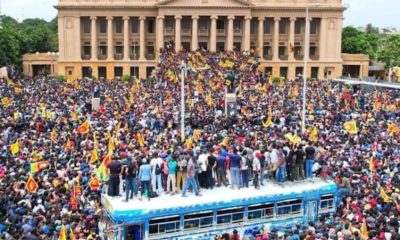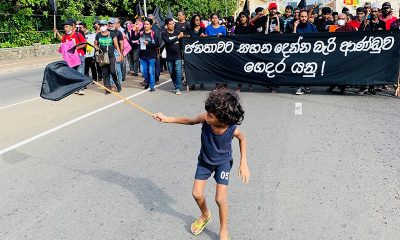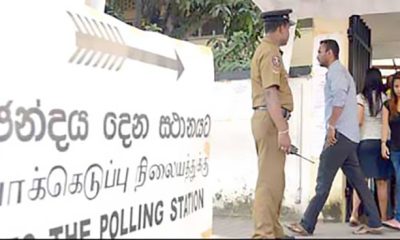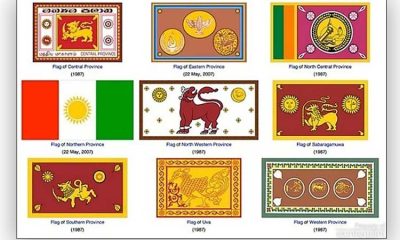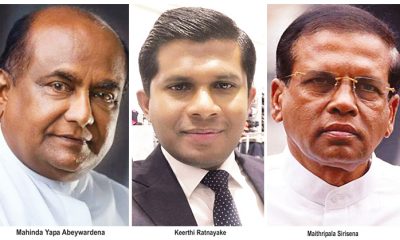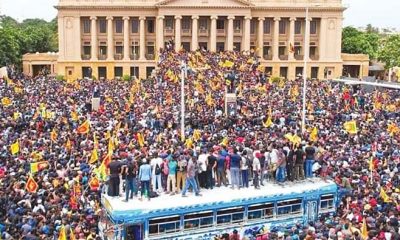Features
ABOLISHING THE EXECUTIVE PRESIDENCY

by Dr Nihal Jayawickrama
The message of the 2022 “Aragalaya”, which drove a President and a Prime Minister and other members of that political family out of office, expressed in clear and explicit terms, was a complete rejection of the authoritarian, patronage-based, corrupt system of governance introduced into this country by the 1978 Constitution and its 21 Amendments. A total of 45 years of autocratic presidential rule marked by massive loss of human life and unprecedented levels of corruption, have demonstrated the need to restore the system of government that this country enjoyed for 25, if not 30, years since 1947.
The Parliamentary Executive System
I am old enough to have lived through all three post-Independence Constitutions of this country, and especially the first. In my view, the 1946 Constitution served the country and its peoples best. If the purpose of a national constitution is to establish the essential framework of government by creating the principal institutions and defining their powers, that was precisely what it did. Drafted by one trained legal draftsman, based on the report of the Soulbury Commission and related documents, and endorsed by the four major communities represented in the State Council, that Constitution served us for 25 years without any significant amendments. Expressed in only 92 sections, it was, in my opinion, the model constitution. If it failed in some respects, it was due to the absence of a Bill of Rights.
Under that parliamentary executive system of government, the Head of State, who was also Head of the Executive, and Commander-in-Chief of the Armed Forces, acted on the advice of the Prime Minister, while the Cabinet of Ministers headed by the Prime Minister and drawn from Parliament was charged with the direction and control of the Government and was collectively responsible to Parliament. That system facilitated regular democratic elections and periodic changes of government which enabled both right-wing and centrist or left-of-centre political parties to implement their respective economic and social policies without any hindrance.
The parliamentary executive system of governance it provided was flexible enough to deal effectively and expeditiously with the sudden death of the Prime Minister in 1951, an island-wide Hartal in 1953, the assassination of the Prime Minister in 1959, the attempted military Coup d’état in 1962, and the bloody JVP Insurgency in 1971. The independence of the Judiciary was protected, and so was that of the Public Service. As a Permanent Secretary under that Constitution during the first two years of my seven-year term, I had the freedom to supervise the departments assigned to the Ministry, subject only to policy directions from my Minister. On one occasion when I refused to comply with a specific non-policy direction, I was reported to the Prime Minister who, fortunately, had a clearer understanding of constitutional principles.
The Constitutional Head of State
For 30 years, the constitutional Head of State was the principal unifying figure in the country; the non-partisan, independent, symbol of the State. Opposition parties could approach the President in the knowledge that he was a neutral figure. When, in 1972, a conflict developed between the Constitutional Court and the National State Assembly, and the Judges refused to speak to the Speaker or the Ministers, it was at President’s House that each party sat on either side of the conference table, with the President at the head, to commence a dialogue to try to resolve their differences.
That exercise, however, failed. When, in 1976, following a long period of “cold war” between the Supreme Court and the Ministry of Justice, the Minister decided it was time to break the ice, and invited the Chief Justice and other Judges of the Supreme Court to the Ministry to tea, it was to President’s House that they proceeded instead, to complain of the invitation, which they perceived to be an interference with the judiciary. Mr William Gopallawa was not a mere ceremonial president; he was not a mere cipher. I was summoned by him on several occasions when he disagreed or felt uncomfortable with advice tendered to him, either by a Minister or the Prime Minister. He did not hesitate to invite the Prime Minister, or the Minister concerned, to reconsider the advice.
The Presidential Executive System
That parliamentary executive system of government was replaced in 1978 by a presidential executive system of government, not because the former, which prevails to this day in democratic countries from Canada and the United Kingdom, through India, Singapore, and Malaysia, to Australia and New Zealand, had somehow failed the people of Sri Lanka. It was replaced not because the people of Sri Lanka cried out aloud nostalgically for a return to some form of monarchical rule.
It was replaced because that was the wish and desire of one senior political leader who probably sincerely believed that that was the best form of government for our country. However, from 1966, during the next seven years, Mr. J.R. Jayewardene failed to convince his party leader, Mr. Dudley Senanayake, of his strong belief that an Executive President chosen directly by the people, seated in power for a fixed number of years, and not subject to the whims and fancies of an elected legislature, was what the country required.
He also proposed an electoral system where there were no electorates; where each political party presented a list of candidates; where the voter voted for the party; and the legislators were chosen from that list, the number depending on the votes cast for each party. He predicted that that system would enable the best equipped men and women in the country to take part in our political life. Little did he know that 50 years later the “best equipped men and women” would include 90 parliamentarians who had not even attempted to sit the GCE “O” Levels. Prime Minister Dudley Senanayake did not support this proposal; nor did the UNP Working Committee.
At the general election of July 1977, when he led his party to an unprecedented five-sixth majority in the National State Assembly (NSA), Prime Minister Jayewardena was able to fulfil his dream project. In October of that year, a Bill to amend the Constitution, certified by his Cabinet as being “urgent in the national interest”, which sought to transfer all the executive powers of the Prime Minister to the President, and for the incumbent Prime Minister to be deemed the first nationally elected President, was passed by the NSA. On February 4, 1978, that constitutional amendment was brought into force, and Mr. Jayewardene was sworn-in on Galle Face Green as the first Executive President of Sri Lanka.
Meanwhile, a Select Committee of the NSA was established to consider the revision of the 1972 Constitution. At the concluding stages of that Committee, the Government tabled a wholly new draft constitution, the author of which was not disclosed. On August 31, 1978, with the TULF and the SLFP walking out, and with none voting against, the NSA enacted the Constitution of the Democratic Socialist Republic of Sri Lanka. On September 8, 1978, the new Constitution was brought into operation, and the 168 members of the NSA were deemed to have been elected as Members of the new Parliament that was established.
Parliamentary Majority Essential
The 1978 Constitution, under which the President was the source of all power and patronage and was beyond the reach of the law and the judiciary, was a Constitution of Mr Jayewardene, by Mr. Jayewardene, for Mr Jayewardene. Dr Colvin R. de Silva’s prescient plea that he should not bequeath it to his successors, was ignored. The success of his project, however, was entirely dependent on one essential factor – that the President elected by the people was supported by a clear majority in the Parliament elected by the people.
I attended a few meetings of the select committee as an adviser to Mrs Bandaranaike and Mr Maithripala Senanayake, since neither of them was a lawyer. At one of the meetings, I had occasion to ask Mr Jayewardene what the position would be if a political party opposed to the President secured a majority in Parliament. He thought that would be unlikely during his term of office, but if that were to happen, he said he would take a step back and be a constitutional Head of State. He, of course, ensured that that did not happen during his presidency by securing an extension of the life of Parliament for a further six-year term through an amendment of the Constitution, a rigged referendum, and through many other devices such as obtaining undated letters of resignation, maintaining secret files on the financial and other activities of his Ministers, and by imposing civic disabilities on his political opponents.
His successors, however, were either not so fortunate, or did not possess his political acumen. In August 1994, UNP President Wijetunge, faced with a Parliament in which the United Front had a majority, chose to take a step back to spend the last three months of his term as a constitutional Head of State. In 2001, President Kumaratunge, faced with a Parliament controlled by the UNP, chose “cohabitation” for a while, and then used her presidential powers to dissolve Parliament prematurely, having previously assured the Speaker that she would never do that while a political party other than her own commanded a working majority. In the next 10 years, both she and President Rajapaksa regularly lured Members of the Opposition to secure the majority which they required, using methods that should have alerted any self-respecting Bribery Commissioner and kept him awake at night.
One does not need to be reminded of the shambolic relationship that prevailed between the President and the Prime Minister in the “Yahapalana” government; nor of the inconceivable situation today where the President is compelled to function with a Cabinet of Ministers and a parliamentary majority politically opposed to him.
A Political Consensus Exists
For over 30 years, every major political party has pledged to restore the parliamentary executive form of government. For that purpose, every major political party has supported the election of the President by Parliament (or other representative body).
In 2000, President Chandrika Kumaratunge, as head of the SLFP government presented a draft Constitution which provided for the President and two Vice-Presidents (the latter drawn from ethnic communities different to that of the President) to be elected by Parliament.
In 2013, the Ranil Wickremesinghe-led UNP published the text of the principles upon which a new Constitution would be formulated after it forms a government. Among them was that the Executive Presidency would be abolished.
In 2015, President Sirisena stood before the casket bearing the remains of the late Rev. Maduluwawe Sobitha and, with his head bowed, swore an oath that he would ensure that all remnants of executive power would be removed from the office of the President of the Republic.
In 2018, a panel of experts appointed by the UNP/SLFP Yahapalana Government led by President Sirisena and Prime Minister Ranil Wickremesinghe prepared and published a draft Constitution which required the President to be elected by Parliament and to exercise many of his/her powers on advice.
In 2018, the JVP headed by Anura Kumara Dissanayake, presented a Bill to amend the Constitution to enable the non-executive President to be elected by Parliament.
In 2021, the SJB led by Sajith Premadasa proposed an amendment to the Constitution to enable a non-executive President to be elected by Parliament.
A Referendum Is Not Required
The 1978 constitution introduced for the first time into the Sri Lankan constitutional process the concept of a referendum. In the tradition of the Greek city states, actual decision-making was being restored to the people. The articles of the constitution which Parliament may not amend without approval at a referendum are regarded as the fundamental elements of the State and are explicitly set out in Article 83. They are: its name (art. 1), its unitary character (art.2), the inalienability of the people’s sovereignty (art.3), its national flag (art.6), its national anthem (art.7), its national day (art.8), the foremost place accorded to Buddhism (art.9), the freedom of thought, conscience and religion (art.10), the prohibition of torture (art.11), any extension of the term of office of the President (art.30), and any extension of the life of Parliament (art.62).
The introduction of a referendum appears to have been intended as a means of ensuring that these fundamental elements would ordinarily remain unaltered. In that regard, the Constitution has distinguished the principle from its implementation. For example, while the life of Parliament or the term of office of the President cannot be extended without approval at a referendum, any reduction of the life or term can be achieved by an amendment passed in Parliament. Similarly, while the concept of the people’s sovereignty is unalterable (thus preventing its alienation to a monarch, a military officer or to a particular community), the manner of its exercise is left to be determined by Parliament. Thus, a requirement that the executive power of the people be exercised by the President on the advice of the Prime Minister is an amendment capable of being made by Parliament by a two-thirds majority without reference to a referendum, as was held by the Supreme Court in 2015.
Unfortunately, the decision of the Bench of three Judges of the Supreme Court (Chief Justice Sripavan and Justices Ekanayake and Dep) on the 19th Amendment which enabled Parliament to amend the Constitution to require the President to act on the advice of the Prime Minister in respect of several matters, has not been followed in subsequent determinations. For example, the proposal made in 2019 by the JVP that the impending election to the office of the then non-executive Presidency be by a majority vote in Parliament was rejected by the Supreme Court. Justice De Abrew held that that would violate Article 4, and that any amendment of Article 4 requires approval by the people at a referendum. Article 4 is not an entrenched provision specified in Article 83. He also ignored the fact that Article 40 of the Constitution already provided for Parliament to elect the President in certain circumstances.
Replacement of List-System with Constituencies
The election of members of parliament from 25 District lists, based on proportional representation, was introduced by Mr. J.R. Jayewardene as an integral element in the presidential executive system of governance. Since each District encompassed several former constituencies, the expenditure involved in campaigning in such a large extent of territory, and the need to raise money for that purpose from various sources, inevitably on a quid pro quo basis, has been identified as one of the principal factors leading to corruption. The return to the single-member/multi-member constituencies, combined with a system of proportional representation to ensure that unrepresented interests are adequately represented, ought to be an essential adjunct to a parliamentary executive system of governance.
Features
The Great and Little Traditions and Sri Lankan Historiography
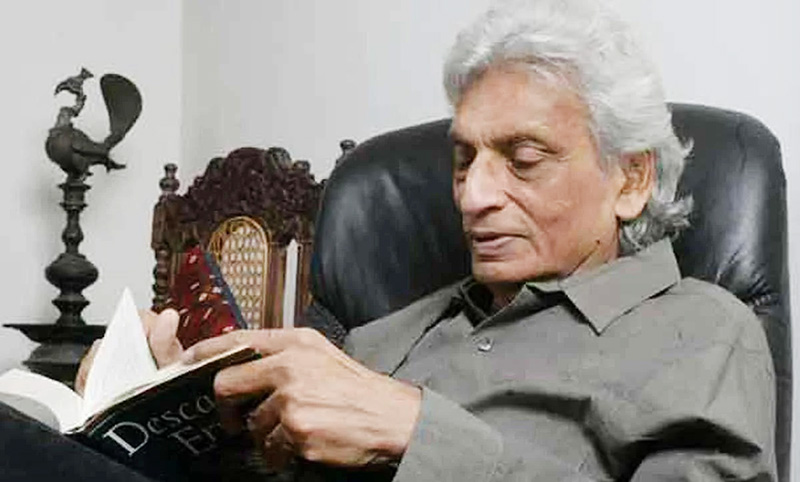
Power, Culture, and Historical Memory:
History, broadly defined, is the study of the past. It is a crucial component of the production and reproduction of culture. Studying every past event is neither feasible nor useful. Therefore, it is necessary to be selective about what to study from the countless events in the past. Deciding what to study, what to ignore, how to study, and how deeply to go into the past is a conscious choices shaped by various forms of power and authority. If studying the past is a main element of the production and reproduction of culture and History is its product, can a socially and culturally divided society truly have a common/shared History? To what extent does ‘established’ or ‘authentic’ History reflect the experiences of those remained outside the political, economic, social, and cultural power structures? Do marginalized groups have their own histories, distinct from dominant narratives? If so, how do these histories relate to ‘established’ History? Historiography today cannot ignore these questions, as they challenge the very notion of truth in History. Due to methodological shifts driven by post-positivist critiques of previously accepted assumptions, the discipline of history—particularly historiography—has moved into a new epistemological terrain.
The post-structuralism and related philosophical discourses have necessitated a critical reexamination of the established epistemological core of various social science disciplines, including history. This intellectual shift has led to a blurring of traditional disciplinary boundaries among the social sciences and the humanities. Consequently, concepts, theories, and heuristic frames developed in one discipline are increasingly being incorporated into others, fostering a process of cross-fertilization that enriches and transforms scholarly inquiry
In recent decades, the discipline of History has broadened its scope and methodologies through interactions with perspectives from the Social Sciences and Humanities. Among the many analytical tools adopted from other disciplines, the Great Tradition and Little Tradition have had a significant impact on historical methodology. This article examines how these concepts, originally developed in social anthropology, have been integrated into Sri Lankan historiography and assesses their role in deepening our understanding of the past.
The heuristic construct of the Great and Little Traditions first emerged in the context of US Social Anthropology as a tool/framework for identifying and classifying cultures. In his seminal work Peasant society and culture: an anthropological approach to civilization, (1956), Robert Redfield introduced the idea of Great and Little Traditions to explain the dual structure of cultural expression in societies, particularly in peasant communities that exist within larger civilizations. His main arguments can be summarized as follows:
a) An agrarian society cannot exist as a fully autonomous entity; rather, it is just one dimension of the broader culture in which it is embedded. Therefore, studying an agrarian society in isolation from its surrounding cultural context is neither possible nor meaningful.
b) Agrarian society, when views in isolation, is a ‘half society’, representing a partial aspect/ one dimension of the broader civilization in which it exits. In that sense, agrarian civilization is a half civilization. To fully understand agrarian society—and by extension, agrarian civilization—it is essential to examine the other half that contribute to the whole.
c) Agrarian society was shaped by the interplay of two cultural traditions within a single framework: the Great Tradition and the Little Tradition. These traditions together provided the unity that defined the civilization embedded in agrarian society.
d) The social dimensions of these cultural traditions would be the Great Society and the Little Society.
e) The Great Culture encompasses the cultural framework of the Great Society, shaped by those who establish its norms. This group includes the educated elite, clergy, theologians, and literati, whose discourse is often regarded as erudite and whose language is considered classical.
f) The social groups excluded from the “Great Society”—referred to as the “Little Society”—have their own distinct traditions and culture. The “Great Tradition” represents those who appropriate society’s surplus production, and its cultural expressions reflect this dominance. In contrast, the “Little Tradition” belongs to those who generate surplus production. While the “Great Tradition” is inherently tied to power and authority, the “Little Tradition” is not directly connected to them.
g) According to Robert Redfield, the Great and Little Traditions are not contradictory but rather distinct cultural elements within a society. The cultural totality of peasant society encompasses both traditions. As Redfield describes, they are “two currents of thought and action, distinguishable, yet overflowing into and out of each other.” (Redfield, 1956).
At the time Redfield published his book Peasant Society and Culture: an Anthropological Approach to Civilization (1956), the dominant analytical framework for studying non-Western societies was modernization theory. This perspective, which gained prominence in the post-World War II era, was deeply influenced by the US geopolitical concerns. Modernization theory became a guiding paradigm shaping research agendas in anthropology, sociology, political science, and development studies in US institutions of higher learning,
Modernization theory viewed societies as existing along a continuum between “traditional” and “modern” stages, with Western industrialized nations positioned near the modern end. Scholars working within this framework argued that economic growth, technological advancement, urbanization, and the rationalization of social structures drive traditional societies toward modernization. The theory often emphasized Western-style education, democratic institutions, and capitalist economies as essential components of this transition.
While engaging with aspects of modernization theory, Redfield offered a more nuanced perspective on non-Western societies. His concept of the “folk-urban continuum” challenged rigid dichotomies between tradition and modernity, proposing that social change occurs through complex interactions between rural and urban ways of life rather than through the simple replacement of one by the other.
The concepts of the Great and Little Traditions gained prominence in Sri Lankan social science discourse through the works of Gananath Obeyesekere, the renowned sociologist who recently passed away. In his seminal research essay, The Great Tradition and the Little in the Perspective of Sinhalese Buddhism (Journal of Asian Studies, 22, 1963), Gananath Obeyesekere applied and adapted this framework to examine key aspects of Sinhalese Buddhism in Sri Lanka. While Robert Redfield originally developed the concept in the context of agrarian societies, Obeyesekere employed it specifically to analyze Sinhala Buddhist culture, highlighting significant distinctions between the two approaches.
He identifies a phenomenon called ‘Sinhala Buddhism’, which represents a unique fusion of religious and cultural traditions: the Great Tradition (Maha Sampradaya) and the Little Traditions (Chuula Sampradaya). To fully grasp the essence of Sinhala Buddhism, it is essential to understand both of these dimensions and their interplay within society.
The Great Tradition represents the formal, institutionalized aspect of Buddhism, centered on the Three Pitakas and other classical doctrinal texts and commentaries of Theravāda Buddhism. It embodies the orthodoxy of Sinhala Buddhism, emphasizing textual authority, philosophical depth, and ethical conduct. Alongside this exists another dimension of Sinhala Buddhism known as the Little (Chuula) Tradition. This tradition reflects the popular, localized, and ritualistic expressions of Buddhism practiced by laypeople. It encompasses folk beliefs, devotional practices (Bali, Thovil), deity veneration, astrology, and rituals (Hadi and Huunium) aimed at securing worldly benefits. Unlike the doctrinally rigid Great Tradition, the Little Tradition is fluid, adaptive, and shaped by indigenous customs, ancestral practices, and even elements of Hinduism. These Sinhala Buddhist cultural practices are identified as ‘Lay-Buddhism’. Gananath Obeyesekera’s concepts and perspectives on Buddhist culture and society contributed to fostering an active intellectual discourse in society. However, the discussion on the concept of Great and Little Traditions remained largely within the domain of social anthropology.
The scholarly discourse on the concepts of Great and Little Tradition gained new socio-political depth through the work of Newton Gunasinghe, a distinguished Sri Lankan sociologist. He applied these concepts to the study of culture and socio-economic structures in the Kandyan countryside, reframing them in terms of production relations. Through his extensive writings and public lectures, Gunasinghe reinterpreted the Great and Little Tradition framework to explore the interconnections between economy, society, and culture.
Blending conventional social anthropology approach with Marxist analyses of production relations and Gramscian perspectives on culture and politics, he offered a nuanced understanding of these dynamics. In the context of our discussion, his key insights on culture, society, and modes of production can be summarized as follows.
a. The social and economic relations of the central highlands under the Kandyan Kingdom, the immediate pre-colonial social and economic order, were his focus. His analysis did not cover to the hydraulic Civilization of Sri Lanka.
b. He explored the organic and dialectical relationship between culture, forces of production, and modes of production. Drawing on the concepts of Antonio Gramsci and Louis Althusser, he examined how culture, politics, and the economy interact, identifying the relationship between cultural formations and production relations
c. Newton Gunasinghe’s unique approach to the concepts of Great Culture and Little Culture lies in his connection of cultural formations to forces and relations of production. He argues that the relationship between a society’s structures and its superstructures is both dialectical and interpenetrative.
d. He observed that during the Kandyan period, the culture associated with the Little Tradition prevailed, rather than the culture linked to the Great Tradition.
e. The limitations of productive forces led to minimal surplus generation, with a significant portion allocated to defense. The constrained resources sustained only the Little Tradition. Consequently, the predominant cultural mode in the Kandyan Kingdom was, broadly speaking, the Little Tradition.
(To be continued)
by Gamini Keerawella
Features
Celebrating 25 Years of Excellence: The Silver Jubilee of SLIIT – II
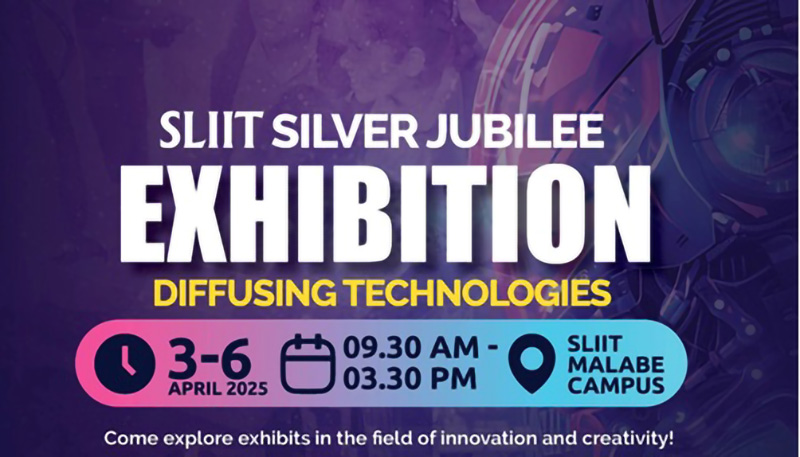
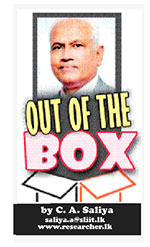 Founded in 1999, with its main campus in Malabe and multiple centres across the country—including Metro Campus (Colombo), Matara, Kurunegala, Kandy (Pallekele), and Jaffna (Northern Uni)—SLIIT provides state-of-the-art facilities for students, now celebrating 25 years of excellence in 2025.
Founded in 1999, with its main campus in Malabe and multiple centres across the country—including Metro Campus (Colombo), Matara, Kurunegala, Kandy (Pallekele), and Jaffna (Northern Uni)—SLIIT provides state-of-the-art facilities for students, now celebrating 25 years of excellence in 2025.
Kandy Campus
SLIIT is a degree-awarding higher education institute authorised and approved by the University Grants Commission (UGC) and Ministry of Higher Education under the University Act of the Government of Sri Lanka. SLIIT is also the first Sri Lankan institute accredited by the Institution of Engineering & Technology, UK. Further, SLIIT is also a member of the Association of Commonwealth Universities (ACU) and the International Association of Universities (IAU).
Founded in 1999, with its main campus in Malabe and multiple centres across the country—including Metro Campus (Colombo), Matara, Kurunegala, Kandy (Pallekele), and Jaffna (Northern Uni)—SLIIT provides state-of-the-art facilities for students, now celebrating 25 years of excellence in 2025.
Since its inception, SLIIT has played a pivotal role in shaping the technological and educational landscape of Sri Lanka, producing graduates who have excelled in both local and global arenas. This milestone is a testament to the institution’s unwavering commitment to academic excellence, research, and industry collaboration.
Summary of SLIIT’s
History and Status
Sri Lanka Institute of Information Technology (SLIIT) operates as a company limited by guarantee, meaning it has no shareholders and reinvests all surpluses into academic and institutional development.
* Independence from Government: SLIIT was established in 1999 as an independent entity without government ownership or funding, apart from an initial industry promotion grant from the Board of Investment (BOI).
* Mahapola Trust Fund Involvement & Malabe Campus: In 2000, the Mahapola Trust Fund (MTF) agreed to support SLIIT with funding and land for the Malabe Campus. In 2015, SLIIT fully repaid MTF with interest, ending financial ties.
* True Independence (2017-Present): In 2017, SLIIT was officially delisted from any government ministry, reaffirming its status as a self-sustaining, non-state higher education institution.
Today, SLIIT is recognised for academic excellence, global collaborations, and its role in producing IT professionals in Sri Lanka
.A Journey of Growth and Innovation
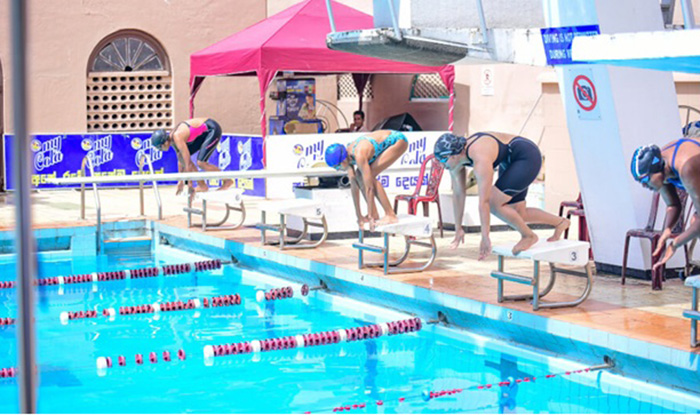
SLIIT began as a pioneering institution dedicated to advancing information technology education in Sri Lanka. Over the past two and a half decades, it has expanded its academic offerings, establishing itself as a multidisciplinary university with programmess in engineering, business, architecture, and humanities, in addition to IT. The growth of SLIIT has been marked by continuous improvement in infrastructure, faculty development, and curriculum enhancement, ensuring that students receive world-class education aligned with industry needs.
Looking Ahead: The Next 25 Years
As SLIIT celebrates its Silver Jubilee, the institution looks forward to the future with a renewed commitment to excellence. With advancements in technology, the rise of artificial intelligence, and the increasing demand for skilled professionals, SLIIT aims to further expand its academic offerings, enhance research capabilities, and continue fostering a culture of innovation. The next 25 years promise to be even more transformative, as the university aspires to make greater contributions to national and global progress.
Sports Achievements:
A Legacy of Excellence
SLIIT has not only excelled in academics but has also built a strong reputation in sports. Over the years, the university has actively promoted athletics and competitive sports by organising inter-university and inter-school competitions, fostering a culture of teamwork, discipline, and resilience. SLIIT teams have secured victories in national and inter-university competitions across various sports, including cricket, basketball, badminton, rugby, football, swimming, and athletics. SLIIT’s sports achievements reflect its dedication to holistic student development, encouraging students to excel beyond the classroom.
Kings of the pool!
Once again, our swimmers have brought glory to SLIIT by emerging as champions at the Asia Pacific Institute of Information and Technology Extravaganza Swimming Championship 2024. They won the Men’s, Women’s, and Overall Championships. Congratulations to all swimmers for their dedication and hard work in the pool, bringing honour to SLIIT.
Winning International Competitions
SLIIT students have participated in and excelled in various international competitions, including Robofest, Codefest, and the University of Queensland – Design Solution for Impact Competition, showcasing their skills and talent on a global stage.
Here’s a more detailed look at SLIIT’s involvement in international competitions:
Robofest:
SLIIT’s Faculty of Engineering organises the annual Robofest competition, which aims to empower students with skills in electronics, robotics, critical thinking, and problem-solving, preparing them to compete internationally and bring recognition to Sri Lankan talent.
Codefest:
CODEFEST is a nationwide Software Competition organized by the Faculty of Computing of Sri Lanka Institute of Information Technology (SLIIT) geared towards exhibiting the software application design and developing talents of students island-wide. It is an effort of SLIIT to elevate the entire nation’s ICT knowledge to achieve its aspiration of being the knowledge hub in Asia. CODEFEST was first organised in 2012 and this year it will be held for the 8th consecutive time in parallel with the 20th anniversary celebrations of SLIIT.
University of Queensland – Design Solution for Impact Competition:
SLIIT hosted the first-ever University of Queensland – Design Solution for Impact Competition in Sri Lanka, with 16 school teams from across the country participating.
International Open Day:
SLIIT organises an International Open Day where students can connect with distinguished lecturers and university representatives from prestigious institutions like the University of Queensland, Liverpool John Moores University, and Manchester Metropolitan University.
Brain Busters:
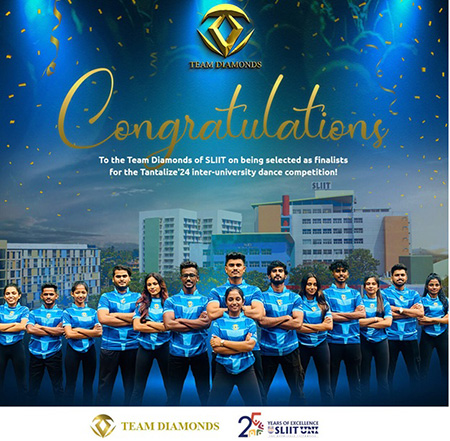
SLIIT Brain Busters is a quiz competition organised by SLIIT. The competition is open to students of National, Private and International Schools Island wide. The programme is broadcast on TV1 television as a series.
Inter-University Dance Competition:
SLIIT Team Diamonds for being selected as finalists and advancing to the Grand Finale of Tantalize 2024, the inter-university dance competition organised by APIIT Sri Lanka. The 14 talented team members from various SLIIT faculties have showcased their skills in Team Diamonds and earned their spot as finalists, competing among over 30 teams from state universities, private universities, and higher education institutes.
Softskills+
For the 11th consecutive year, Softskills+ returns with an exciting lineup of events aimed at honing essential soft skills among students. The program encompasses an interschool quiz contest and a comprehensive workshop focused on developing teamwork, problem-solving abilities, leadership qualities, and fostering creative thinking.
Recently, the Faculty of Business at SLIIT organised its annual Inter-school Quiz Competition and Soft Skills Workshop, marking its fifth successive year. Targeting students in grades 11 to 13 from Commerce streams across State, Private, and International schools, the workshop sought to ignite a passion for soft skills development, emphasising teamwork, problem-solving, creativity, and innovative thinking. Recognising the increasing importance of these soft skills in today’s workforce, the programme aims to fill the gap often left unaddressed in the school curriculum.”
The winners of the soft skill competition with Professor Lakshman Rathnayake: Chairman/Chancellor, Vice Chancellor/MD Professor Lalith Gamage, Professor Nimal Rajapakse: Senior Deputy Vice – Chancellor & Provost, Deputy Vice Chancellor – Research and International Affairs Professor Samantha Thelijjagoda, and Veteran Film Director Somarathna Dissanayake.
VogueFest 2024:
SLIIT Business School organised VogueFest 2024, a platform for emerging fashion designers under 30 to showcase their work and win prizes.
T-shirt Design Competition with Sheffield Hallam University:
SLIIT and Sheffield Hallam University (SHU) UK collaborated on a T-shirt designing competition, with a voting procedure to select the best design.
SLIIT’s Got Talent
: The annual talent show, SLIIT’s Got Talent 2024, was held for the 10th consecutive year at the Nelum Pokuna Mahinda Rajapaksa Theatre on 27th September 2024. SLIIT’s Got Talent had the audience energised with amazing performances, showcasing mind-blowing talent by the orchestra and the talented undergraduates from all faculties.
Other events:
* SLIIT also participates in events like the EDUVision Exhibition organised by the Richmond College Old Boys’ Association.
* They hosted the first-ever University of Queensland – Design Solution for Impact Competition in Sri Lanka.
* SLIIT Business School also organised the Business Proposal Competition.
SLIIT Academy:
SLIIT Academy (Pvt.) Ltd. provides industrial-oriented learning experiences for students.
International Partnerships:
SLIIT has strong international partnerships with universities like Liverpool John Moores University (LJMU), The University of Queensland (UQ), Manchester Metropolitan University (MMU), and Curtin University Australia, providing opportunities for students to study and participate in international events.
(The writer, a senior Chartered Accountant and professional banker, is Professor at SLIIT University, Malabe. He is also the author of the “Doing Social Research and Publishing Results”, a Springer publication (Singapore), and “Samaja Gaveshakaya (in Sinhala).
Features
Inescapable need to deal with the past
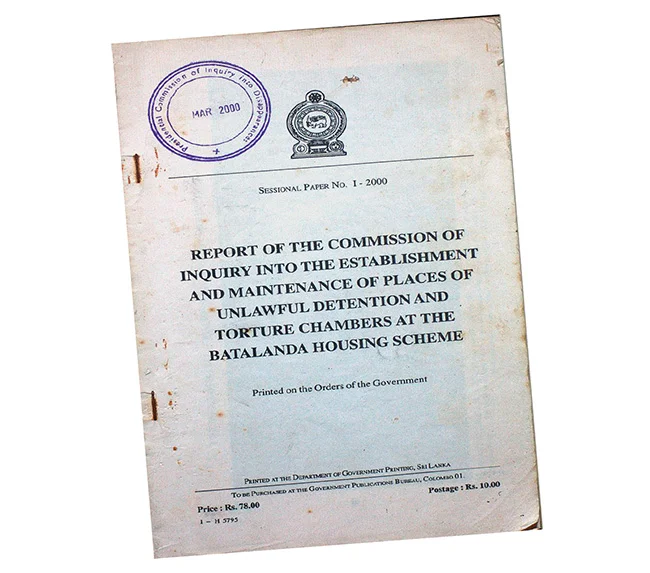
The sudden reemergence of two major incidents from the past, that had become peripheral to the concerns of people today, has jolted the national polity and come to its centre stage. These are the interview by former president Ranil Wickremesinghe with the Al Jazeera television station that elicited the Batalanda issue and now the sanctioning of three former military commanders of the Sri Lankan armed forces and an LTTE commander, who switched sides and joined the government. The key lesson that these two incidents give is that allegations of mass crimes, whether they arise nationally or internationally, have to be dealt with at some time or the other. If they are not, they continue to fester beneath the surface until they rise again in a most unexpected way and when they may be more difficult to deal with.
In the case of the Batalanda interrogation site, the sudden reemergence of issues that seemed buried in the past has given rise to conjecture. The Batalanda issue, which goes back 37 years, was never totally off the radar. But after the last of the commission reports of the JVP period had been published over two decades ago, this matter was no longer at the forefront of public consciousness. Most of those in the younger generations who were too young to know what happened at that time, or born afterwards, would scarcely have any idea of what happened at Batalanda. But once the issue of human rights violations surfaced on Al Jazeera television they have come to occupy centre stage. From the day the former president gave his fateful interview there are commentaries on it both in the mainstream media and on social media.
There seems to be a sustained effort to keep the issue alive. The issues of Batalanda provide good fodder to politicians who are campaigning for election at the forthcoming Local Government elections on May 6. It is notable that the publicity on what transpired at Batalanda provides a way in which the outcome of the forthcoming local government elections in the worst affected parts of the country may be swayed. The problem is that the main contesting political parties are liable to be accused of participation in the JVP insurrection or its suppression or both. This may account for the widening of the scope of the allegations to include other sites such as Matale.
POLITICAL IMPERATIVES
The emergence at this time of the human rights violations and war crimes that took place during the LTTE war have their own political reasons, though these are external. The pursuit of truth and accountability must be universal and free from political motivations. Justice cannot be applied selectively. While human rights violations and war crimes call for universal standards that are applicable to all including those being committed at this time in Gaza and Ukraine, political imperatives influence what is surfaced. The sanctioning of the four military commanders by the UK government has been justified by the UK government minister concerned as being the fulfilment of an election pledge that he had made to his constituents. It is notable that the countries at the forefront of justice for Sri Lanka have large Tamil Diasporas that act as vote banks. It usually takes long time to prosecute human rights violations internationally whether it be in South America or East Timor and diasporas have the staying power and resources to keep going on.
In its response to the sanctions placed on the military commanders, the government’s position is that such unilateral decisions by foreign government are not helpful and complicate the task of national reconciliation. It has faced criticism for its restrained response, with some expecting a more forceful rebuttal against the international community. However, the NPP government is not the first to have had to face such problems. The sanctioning of military commanders and even of former presidents has taken place during the periods of previous governments. One of the former commanders who has been sanctioned by the UK government at this time was also sanctioned by the US government in 2020. This was followed by the Canadian government which sanctioned two former presidents in 2023. Neither of the two governments in power at that time took visibly stronger stands.
In addition, resolutions on Sri Lanka have been a regular occurrence and have been passed over the Sri Lankan government’s opposition since 2012. Apart from the very first vote that took place in 2009 when the government promised to take necessary action to deal with the human rights violations of the past, and won that vote, the government has lost every succeeding vote with the margins of defeat becoming bigger and bigger. This process has now culminated in an evidence gathering unit being set up in Geneva to collect evidence of human rights violations in Sri Lanka that is on offer to international governments to use. This is not a safe situation for Sri Lankan leaders to be in as they can be taken before international courts in foreign countries. It is important for Sri Lanka’s sovereignty and dignity as a country that this trend comes to an end.
COMPREHENSIVE SOLUTION
A peaceful future for Sri Lanka requires a multi-dimensional approach that addresses the root causes of conflict while fostering reconciliation, justice, and inclusive development. So far the government’s response to the international pressures is to indicate that it will strengthen the internal mechanisms already in place like the Office on Missing Persons and in addition to set up a truth and reconciliation commission. The difficulty that the government will face is to obtain a national consensus behind this truth and reconciliation commission. Tamil parties and victims’ groups in particular have voiced scepticism about the value of this mechanism. They have seen commissions come and commissions go. Sinhalese nationalist parties are also highly critical of the need for such commissions. As the Nawaz Commission appointed to identify the recommendations of previous commissions observed, “Our island nation has had a surfeit of commissions. Many witnesses who testified before this commission narrated their disappointment of going before previous commissions and achieving nothing in return.”
Former minister Prof G L Peiris has written a detailed critique of the proposed truth and reconciliation law that the previous government prepared but did not present to parliament.
In his critique, Prof Peiris had drawn from the South African truth and reconciliation commission which is the best known and most thoroughly implemented one in the world. He points out that the South African commission had a mandate to cover the entire country and not only some parts of it like the Sri Lankan law proposes. The need for a Sri Lankan truth and reconciliation commission to cover the entire country and not only the north and east is clear in the reemergence of the Batalanda issue. Serious human rights violations have occurred in all parts of the country, and to those from all ethnic and religious communities, and not only in the north and east.
Dealing with the past can only be successful in the context of a “system change” in which there is mutual agreement about the future. The longer this is delayed, the more scepticism will grow among victims and the broader public about the government’s commitment to a solution. The important feature of the South African commission was that it was part of a larger political process aimed to build national consensus through a long and strenuous process of consultations. The ultimate goal of the South African reconciliation process was a comprehensive political settlement that included power-sharing between racial groups and accountability measures that facilitated healing for all sides. If Sri Lanka is to achieve genuine reconciliation, it is necessary to learn from these experiences and take decisive steps to address past injustices in a manner that fosters lasting national unity. A peaceful Sri Lanka is possible if the government, opposition and people commit to truth, justice and inclusivity.
by Jehan Perera
-
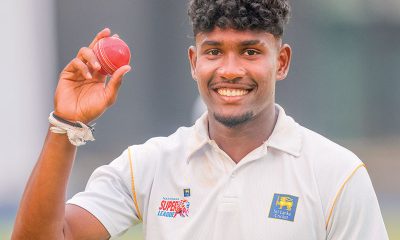
 Sports4 days ago
Sports4 days agoSri Lanka’s eternal search for the elusive all-rounder
-
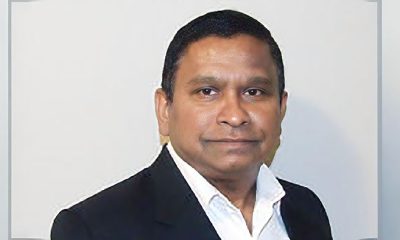
 News2 days ago
News2 days agoBid to include genocide allegation against Sri Lanka in Canada’s school curriculum thwarted
-
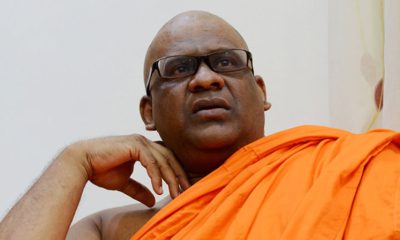
 News4 days ago
News4 days agoGnanasara Thera urged to reveal masterminds behind Easter Sunday terror attacks
-
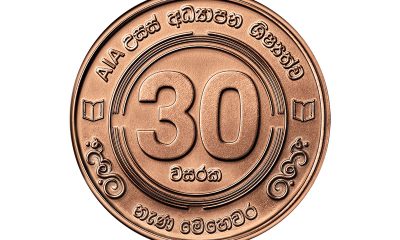
 Business6 days ago
Business6 days agoAIA Higher Education Scholarships Programme celebrating 30-year journey
-
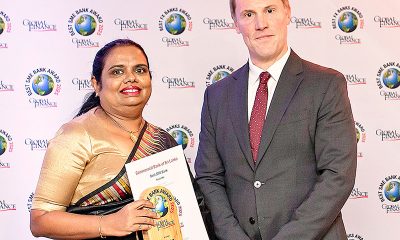
 News3 days ago
News3 days agoComBank crowned Global Finance Best SME Bank in Sri Lanka for 3rd successive year
-
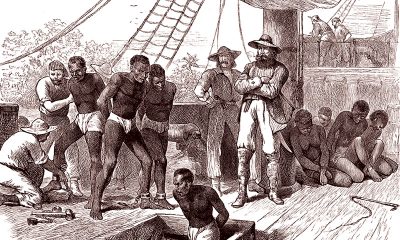
 Features4 days ago
Features4 days agoSanctions by The Unpunished
-
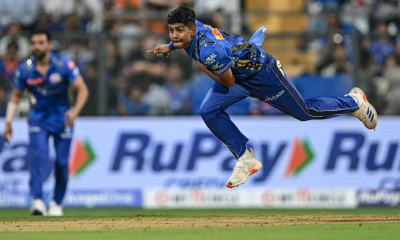
 Latest News2 days ago
Latest News2 days agoIPL 2025: Rookies Ashwani and Rickelton lead Mumbai Indians to first win
-
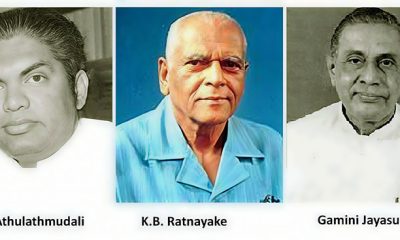
 Features4 days ago
Features4 days agoMore parliamentary giants I was privileged to know


